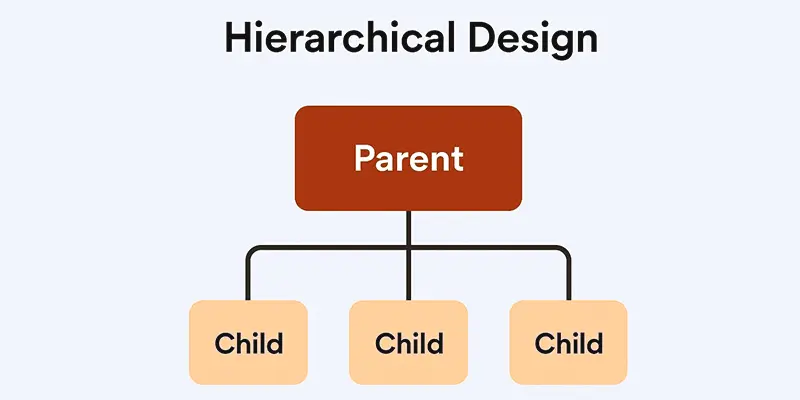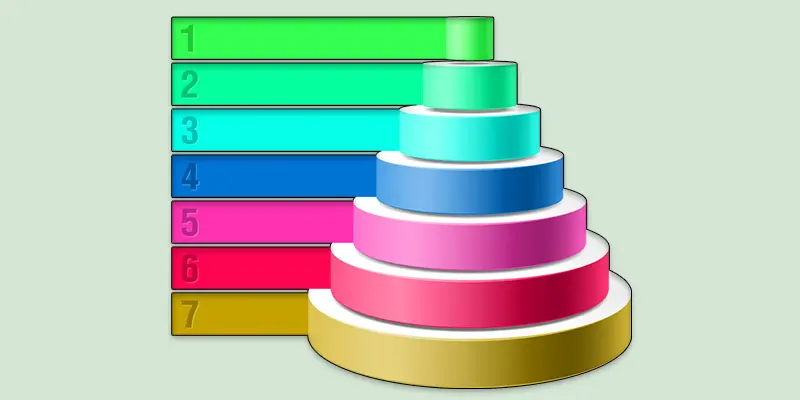What Is Hierarchical Design? Key Applications, Advantages and Disadvantages
Published: 17 May 2025
Hierarchical Design
Hierarchical design is everywhere— from company structures to computer file systems, ensuring clear organization and efficiency. But have you ever wondered why some systems feel more structured than others? Many struggle with complex workflows because of poor hierarchy, leading to confusion and inefficiency. Imagine opening a website with no clear navigation—frustrating, right? Whether in software, businesses, or daily life, hierarchical design keeps things organized, making everything easier to manage.
What is Hierarchical Design
Hierarchical design is a structured approach where elements are organized in a top-down manner, with higher levels controlling lower ones. Its main purpose is to bring clarity and efficiency to complex systems. It was first widely used in networking and organizational management, making it ideal for businesses, network infrastructures, and data management systems.

Key Characteristics of Hierarchical Design
Hierarchical design is known for its clear structure and organized flow. Here are the key characteristics that define this approach:
- Top-Down Structure: The design follows a parent-child relationship, with higher levels controlling and managing the lower levels.
- Clear Roles and Responsibilities: Each level has a defined role, making it easy to understand who is responsible for what.
- Scalability: New layers can be added to the hierarchy without disrupting the overall structure.
- Organized Flow of Information: Information typically flows from top to bottom, ensuring efficient communication and decision-making.
- Efficiency in Management: By breaking down tasks into layers, hierarchical design simplifies management and improves control over complex systems.
- Control and Accountability: Higher levels have control over lower levels, ensuring proper oversight and accountability throughout the structure.
Applications of Hierarchical Design
Hierarchical design is widely used across various fields to bring clarity and organization. By structuring elements in a top-down manner, it makes complex systems easier to manage and understand.
Applications of Hierarchical Design
- Computer File Systems: Organizes files and folders in a tree-like structure for easy access and management.
- Database Models: Used in XML or tree-based models to organize and store data in a parent-child format.
- Organizational Structures: Defines roles and responsibilities, with managers overseeing subordinates in a clear chain of command.
- Website Navigation: Menus are organized in a hierarchy, making it easier for users to find information.
- Software Development: Structures code and modules to ensure easy maintenance and scalability.
- Education Systems: Hierarchical levels like teachers, students, and administrators create clear roles and workflows.
- Biological Classifications: Categorizes living organisms into a hierarchy, such as kingdom, phylum, class, etc.

Advantages & Disadvantages of Hierarchical Design
Hierarchical design offers a clear and structured way to organize systems, making it easier to manage and scale. However, like any approach, it comes with its own set of advantages and disadvantages. Below, we’ll explore both the benefits and limitations of using hierarchical design in various systems.
Advantages
- Clear Structure: Hierarchical design creates a clear and organized structure, making it easy to understand relationships between elements.
- Improved Management: With a top-down approach, it’s easier to manage tasks, responsibilities, and workflows.
- Scalability: As systems grow, it’s easy to add new layers or elements without disrupting the overall structure.
- Efficient Communication: Information flows smoothly from the top to the bottom, making communication clearer.
- Simplifies Decision-Making: Clear roles and responsibilities help in quicker and more efficient decision-making.
Disadvantages
- Lack of Flexibility: Hierarchical structures can become rigid, making it harder to adapt or change quickly.
- Slow Communication: Lower levels may face delays in communication or decision-making as they depend on upper levels.
- Complexity with Too Many Layers: Adding too many layers or levels can complicate the structure and make it difficult to manage.
- Potential for Overlap: In some cases, roles or responsibilities might overlap between levels, causing confusion.
- Limited Innovation: A rigid structure can stifle creativity and innovation, especially in more dynamic fields.
Best Practices for Implementing Hierarchical Design
Implementing hierarchical design effectively can bring structure and clarity to complex systems. Following best practices ensures that the system remains efficient, scalable, and easy to manage.
- Keep it Simple: Avoid adding unnecessary layers. A complex hierarchy can become difficult to navigate and manage.
- Clearly Define Roles: Ensure each level has a well-defined role and responsibility, making the hierarchy clear and easy to follow.
- Maintain Flexibility: While the design is structured, allow for some flexibility to adapt to changes as the system grows or evolves.
- Ensure Effective Communication: Establish clear communication channels between levels to ensure smooth information flow.
- Focus on Scalability: Plan your design so it can easily scale as your system or organization grows, without compromising performance.
- Review Regularly: Regularly evaluate the design to identify areas for improvement or to update the hierarchy based on changing needs.
- Balance Control and Autonomy: Ensure lower levels have enough autonomy to make decisions, but still maintain overall control from higher levels.

Conclusion About Hierarchical Design
We’ve covered hierarchical design in detail, exploring its definition, applications, advantages, and best practices. I personally recommend implementing this design in systems that require clear structure and scalability, as it can greatly improve efficiency and organization. If you’re working on a project or managing a team, hierarchical design might just be the solution you need. Don’t forget to share your thoughts or experiences with hierarchical design in the comments below!
FAQS Nested Hierarchies
The three layers of a hierarchical design model typically include the top level, which controls the system, the middle level, which manages and organizes, and the bottom level, where tasks are executed. This structure allows for efficient management and scalability. Each layer depends on the one above it for direction and control.
A hierarchical study design refers to organizing research or data collection in a structured, layered way. It breaks down the study into different levels or categories, often from general to specific. This approach helps in organizing complex research, ensuring that all aspects are covered systematically.
The concept of hierarchical refers to a system where elements are arranged in a top-down structure, with each level having authority over the one below it. This organization creates clear relationships and simplifies decision-making. Hierarchical structures are commonly used in businesses, governments, and computer systems.
Cohort studies, case studies, randomized controlled trials (RCTs), systematic reviews, and expert opinion are the five levels of evidence. These levels rank the reliability of evidence based on the strength of research methods. The higher the level, the more reliable and valid the evidence is considered.
The hierarchy of evidence in research ranks studies based on their quality and reliability. The highest ranked studies are RCTs, systematic reviews, case-control studies, case reports, and cohort studies. This hierarchy helps researchers determine the most trustworthy information for decision-making.
The four main types of evidence in research are empirical evidence, theoretical evidence, experiential evidence, and statistical evidence. Each type plays a role in supporting research findings. Together, they help form a comprehensive understanding of the topic being studied.
A level 4 study usually refers to case series or case reports, which are considered lower in the evidence hierarchy. These studies focus on a small group of individuals or a single case, providing valuable insights but lacking the strength of more controlled studies. While useful, they are not as reliable as higher-level studies like randomized trials.

- Be Respectful
- Stay Relevant
- Stay Positive
- True Feedback
- Encourage Discussion
- Avoid Spamming
- No Fake News
- Don't Copy-Paste
- No Personal Attacks

- Be Respectful
- Stay Relevant
- Stay Positive
- True Feedback
- Encourage Discussion
- Avoid Spamming
- No Fake News
- Don't Copy-Paste
- No Personal Attacks





